Every man or Woman for Himself in the Electricity Sector
BY Eng Parakrama Jayasinghe
Sri Lankans would not have forgotten the advice given by one of our former Presidents that the “Citizens should look after their own security”.
It appears that the Electricity Consumers are now faced with this choice given the upheavals and shocks received in recent times, with the Damocles Sward of a further hefty tariff hike on the cards. The Minister of Power is expected to present his Cabinet Proposal asking for a further 86% increase on top of the 75% already imposed on the electricity consumer tariff as anew year gift to the nation.
Even with the hope that such most unwarranted price increase may not be allowed, the threat of continued increases cannot be ignored, given the total lack of any visionary approach to this issue for which there are enough and more solutions abound.
However, taking a lesson from past happenings, which led us to this quagmire, it is high time that the consumers accepted the fact that they will have to fend for themselves.
Fortunately such options are now emerging, commencing from the very basic intervention of the consumers themselves individually, by conservation of energy and more vigilance in the use of the energy consuming equipment. This will provide immediate monetary benefits to the consumers as well as provide a modicum of relief to those less able to engage in such moves, by reducing the overall cost of generation of the CEB and hopefully averting any more ad-hoc tariff increases .
The word DSM- Demand Side Management is bandied about often by the authorities , but very little seems to be done to adopt same. The well known axiom states that Nega Watts are much cheaper than Mega Watts . We the consumers can take up the challenge ourselves to help ourselves and well as the country. This is the lowest hanging fruit and will deliver dividends from the day one at practically no cost. Let us look at a few options.

The very detailed analysis done by the Sri Lanka Sustainable Energy Authority (SLSEA) in Kurunegala which I think is equally valid anywhere else in the country, is a good indicator on options available.
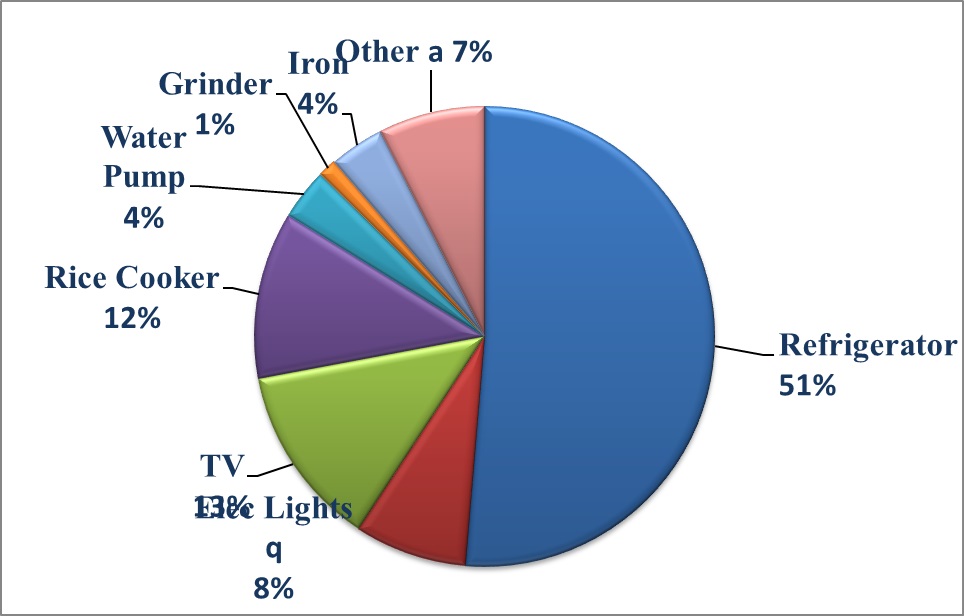
While opting for a more efficient inverter type refrigerator may not be feasible in these difficult times, even the existing one can be made to be less energy consuming by observing some simple rules. These are readily available in the SLSEA website and only one illustration is given below to nudge you in the right direction.

Similar care can be taken in case of the use of the TV and Irons etc. Even the Rice cooker, now an ubiquitous equipment in most households, can be made to work energy efficiently.
When it comes to lights, there is no excuse but to convert to LEDS, even if you presently use CFL bulbs. It is reported that some year ago the promotions of CFL bulbs to replace incandescent bulbs resulted in an annual saving of 450 GWh of electricity. Similar results can be expected now even by the change from CFL to LEDs. Of course, one may argue that the current market price of LEDs has taken them out of reach of most people. Who can spare nearly Rs 1000.00 for a mere light bulb when you can buy few kilos of rice with that money. However, those who can spare the cash would find it a worthwhile investment as shown below.
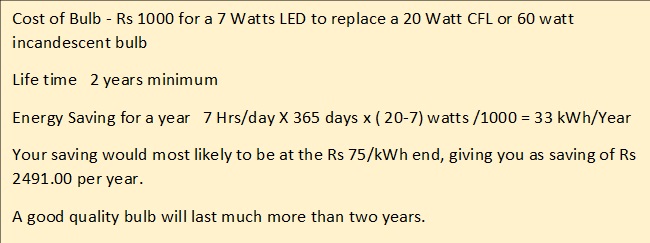
But taken on a national scale the following is worth noting.
In 2018 the CEB made an award for 10,000,000 LED bulbs to a Vietnamese Company at an FOB price of $ 0.872. Nothing is known if this purchase was made and the bulbs duly distributed. If this was followed up in a logical fashion the impact on the National grid and the CEB would have been

The other relevant question to be asked is, if the price of LED bulbs was only $ 0.872 how come they are being sold at a price of Rs 1000 in the market? A fair price would have been less than Rs 500.00 even at the current devalued state of the Rupee.
So, while we await the state authorities to wake up, let us make our own contribution by changing over to LEDs even at the present black market prices, following the example set with the CFLs
The options available to the corporate sector are also significant as shown below, developed once more thanks to be efforts of the SLSEA.
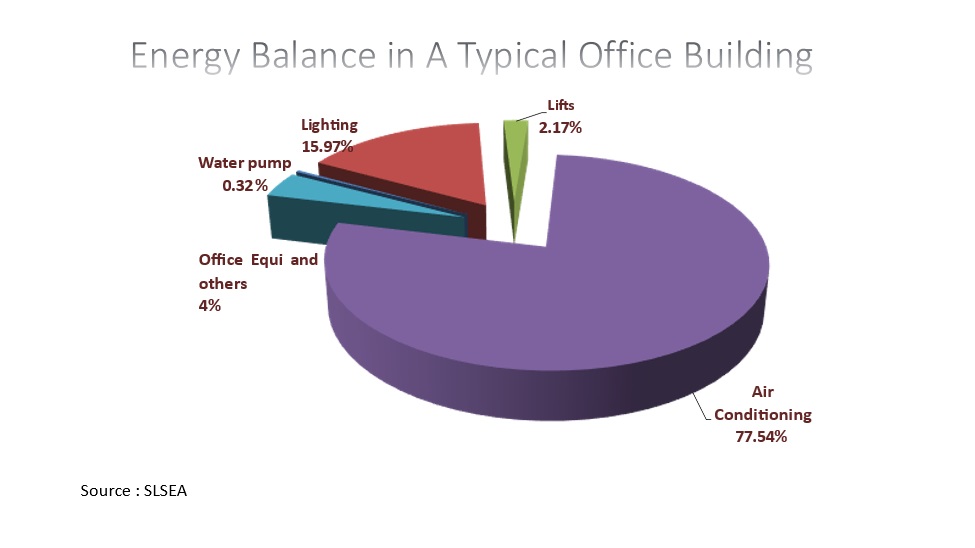
The largest chunk of electricity consumption is by the Air Conditioners. While there are many changes that can be done, the cost of which can be recovered in a matter of months, one immediate step that can be done is by increasing the set point. It is often seen that the employees sometimes need be clad in warm clothing in the office, while stepping out to the scorching sun risking heat stroke. It has been proven that just 1 degree increase in the set point temperature of airconditioned spaces could result in a 6% reduction in energy consumption. That would mean a lot of Bucks with the current price of electricity.
While commitments individually to switch off unnecessary fans and lights etc. are contributions that can be made by each employee, who must also collectively treat this as a national service, not merely a means of saving some expense to the employer.
There are many other simple good practices which can be adopted resulting in significant saving of energy consumption. Details of these can be obtained from the SLSEA and are also published in their web www.energy.gov.lk.
In this regard, the assignment of the task of ensuring a pre-determined saving of consumption to an Energy Manager would be a good idea for any institution.
This is a requirement now for institutions consuming more than 50,000 kWh/month of electricity under the SLSEA regulations to appoint an Energy Manager. Unfortunately, the request to the Cabinet to make this mandatory has been turned down in their wisdom. With the recent hike in consumer tariff, even those with lower consumption may find employing an energy manager a prudent investment.
While the above are efforts that can be made by individual and institutional consumers to reduce their consumption, and thereby mitigate the already implemented and impending further tariff hikes, it is also now possible for them to embark on ventures to gain further independence and insulation against the risks of ad hoc tariff increases by the utility and the ministry, to cover up their past sins and the ongoing honey moon with imported fossil fuels, at the consumers expense, even to the extent of trying to add one more imponderable by way of LNG.
Surya Bala Sangraamaya (SBS)
The vibrant progress of the SBS until mid 2022, created a most visible impact on the RE contribution amounting to over 650 MW of Roof Top Solar power and PROSUMER base of over 45,000. The saving in oil based electricity generation thereby reached of 71,500 MWh per month and thus a direct reduction of $ 230.6 Million or Rs 85.33 Billion annually from the drain of foreign exchange expenditure on oil based generation.

The true potential was not realized, which would have even raised this contribution to over 1000 MW by now with the comfort of 1,752 GWh per annum added to the national grid, being 12% of the demand, at a constant cost of Rs 19.09 per kWh for the next 20 years. The Utility lacked the foresight to profit from that bounty.
But as it may, the financial parameters changed drastically in 2022 making it impossible for any investor to enter the industry at the former feed in tariff. The deliberations of the Tariff Committee over many months came out with a damp squib offering only Rs 37.00 per kWh for units up to 500 kW and even less at Rs 34.50 per kWh for larger systems, which the members of the Committee were well aware are not adequate to attract the required investments. On a more positive note, the Utility did remove some technical barriers and also publicly announced the feasibility of absorbing up to 2500 MW of Solar and Wind power to the grid without the need for major investments on the transmission system. This was a welcome attitude change which failed to garner the desired result due to the external influences which resulted in the declaration of the non-viable Feed in Tariff. This is particularly so for the larger systems which are urgently needed to overcome the present financial and energy supply crisis by addition of large amounts of Solar PV in a short time at no expense to the CEB or the state.
Near 50% of the 650 MW of Solar PV penetration came from Net Plus accounts which were relatively larger systems adding directly to reduce the burden on the Grid. This has now come to a standstill due to the failure to provide a commercially viable FIT offered for the larger systems. And thus, dried up a possible source of foreign investments to a sector which could have offered immediate short-term solution to the current crisis
However, the provisions of the SBS, even at the declared FIT of Rs 37.00 may prove acceptable to some larger individual and commercial customers, when considered in relation to the already increased tariff.
A sample calculation based on the two systems Net Metering and Net Accounting are given below.
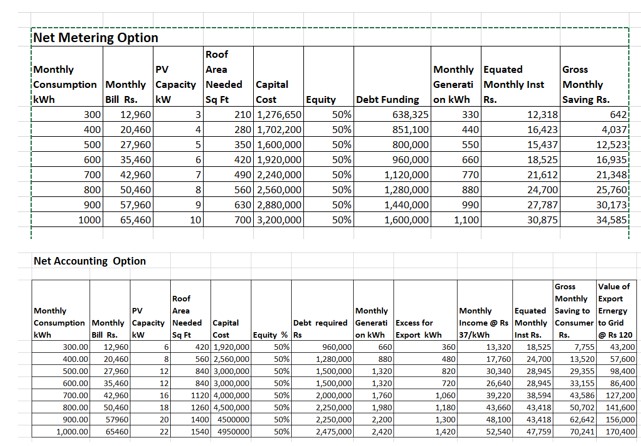
Both systems assume debt funding up to 50% over a 7 year payback and a concessionary interest rate of 15%. While this may appear fanciful in comparison of the insane market interest rate of over 30%, some banks have come forward to commit some limited funds at such rates in the interest of national need.
But the Net Accounting option appears attractive even if more equity funds are committed, as there is a healthy return for such commitment. Fortunately for Sri Lanka there had been such individuals who did not purely go by the possible financial returns on the funds committed, when the roof top Solar PV system was initiated without any concessionary debt funding from ADB etc. and even before the launching of the SBS. It is due to their generosity that the industry was able to survive and thrive to the great benefit to the country. One could only hope that there would be even more of such people who could spare a million or two in a truly a national venture as shown by both the personal returns and the even greater contribution to the grid. This number which cannot be refuted would answer the type of objections that could come from the CEB that this would wean away their high-end customers. Obviously, their gain would far exceed such reduction in income by eliminating the need for oil-based generation. Hope they could appreciate this and would not try to pose any barriers on those who are willing to come to their assistance, instead of the proposed Ad Hoc tariff increases as the only means of survival.
The main driving force behind this widow of opportunity is of course the current average cost of electricity for the high-end consumers as seen below.
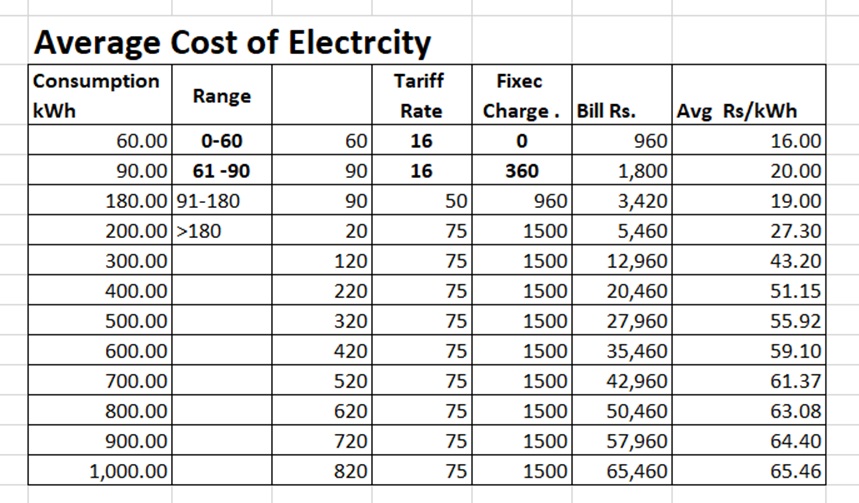
If the proposed additional tariff increase is imposed, it will further drive the high-end consumers away from the grid, as they are seeking none dependence from the grid with the added advantage of security against extended power cuts, by the addition of some batteries. The above two systems do not give them this protection against the power cuts, which will be here to stay for a while, in spite of the rhetoric of the Minister and the CEB officials. The costs of this option are not prohibitive as the CEB engineers continue portray. This option will be examined in detail in a later article. Meanwhile, those interested can contact the author for discussions. My colleagues at the Solar Industries Association will also be pleased to assist you to evaluate the options available.
You are on your own
As the Sinhala adage says “ තමා හිසට තම අතමය සෙවනල්ල” The only shade to be expected for your head comes from your own hand. This certainly appears true in case of the Electricity Sector in Sri Lanka
 Eng. Parakrama Jayasinghe
Eng. Parakrama Jayasinghe
is a Chartered Mechanical Engineer with a BSc Eng (honours) degree from the University of Peradeniya. He is fellow of the Institution of Engineers Sri Lanka and a Member of the Institution of Mechanical Engineers London.




